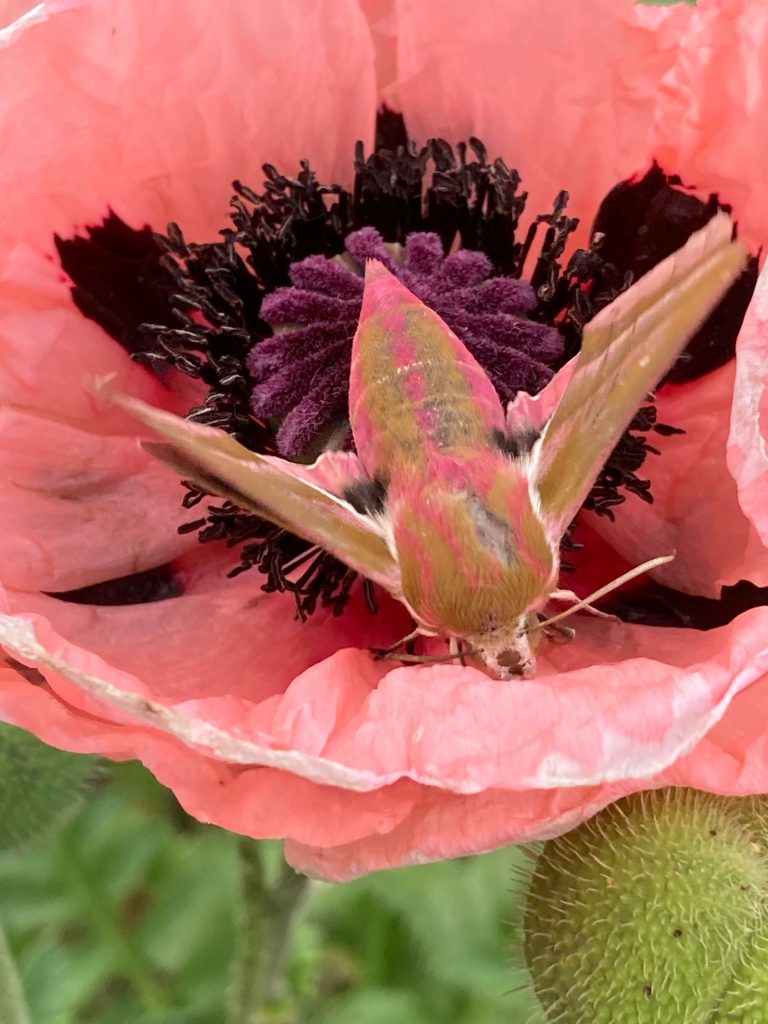Anna (Plot 93) sent these photos of recent sightings on her plot of this Elephant Hawk Moth and caterpillar.


I am aware of one other reported siting of an Elephant Hawk on site, but that goes back many years to 2017. I recall David (Plot 53) was the lucky host that time. (See the related post below.) If any plotter can provide info of other examples we’d love to hear from you.
It’s pleasing to think our efforts to green the site may be providing more habitats for unusual wildlife like the Elephant Hawk Moth.
Here’s what Chat GPT had to say about habitats attractive to them.
A Beginner’s Guide to the Lifecycle of the Elephant Hawk Moth and Its Preferred Habitat
The Elephant Hawk Moth (Deilephila elpenor) is a fascinating and visually striking insect found in various regions across Europe and parts of Asia. Its distinctive appearance, including its large size and vibrant colors, makes it a popular subject for nature enthusiasts and amateur entomologists. In this beginner’s guide, we will explore the lifecycle of the Elephant Hawk Moth and its preferred habitat.
1. Eggs:
The lifecycle of the Elephant Hawk Moth begins with the female laying her small, spherical eggs on the leaves of its host plants. These plants typically include willowherbs (Epilobium species) and bedstraws (Galium species). The eggs are pale green in color and are usually laid in clusters to increase the chances of survival.
2. Larvae (Caterpillars):
After about a week, the eggs hatch, giving rise to the larvae or caterpillar stage of the Elephant Hawk Moth’s lifecycle. The caterpillar is striking in appearance, sporting bright colors like lime green and having eye-catching eye-like markings on its head. It has a horn-like structure on its rear, which lends it the name “hornworm.”
3. Feeding and Growth:
The caterpillars are voracious eaters and immediately begin to feed on the leaves of their host plants. They undergo several stages of molting as they grow in size, shedding their old skin to accommodate their increasing body mass. The caterpillar stage lasts for about 4-5 weeks, during which they can grow up to 8-9 centimeters in length.
4. Pupation:
As the caterpillar reaches its full size, it undergoes pupation, which is the transformation into a pupa or chrysalis. The pupa is usually formed in a protected location away from direct predators and environmental hazards. The Elephant Hawk Moth pupa is reddish-brown and has a smooth texture, blending well with its surroundings.
5. Metamorphosis:
Inside the pupa, a miraculous transformation takes place. The caterpillar’s body undergoes significant changes, breaking down its tissues and reassembling them into the adult moth’s structures. This metamorphosis process generally lasts for about 2-3 weeks.
6. Adult Moth:
Finally, the adult Elephant Hawk Moth emerges from the pupa. At this stage, it becomes active at dusk and during the night, while resting during the day. The Elephant Hawk Moth is a large and impressive moth with a wingspan of about 5-7 centimeters. Its wings are predominantly pink or olive-green, providing excellent camouflage when resting on tree trunks or leaves.
Preferred Habitat:
The Elephant Hawk Moth can be found in a variety of habitats, but it tends to favor areas with plenty of nectar-rich flowers for adult feeding and suitable host plants for caterpillar development. Woodlands, hedgerows, gardens, and meadows are common places to encounter this magnificent moth.
1. Nectar Sources:
Adult Elephant Hawk Moths primarily feed on nectar from a range of flowers, including honeysuckle (Lonicera species), petunias (Petunia species), and jasmine (Jasminum species). Having a variety of these nectar-rich plants in the habitat will attract these moths.
2. Host Plants:
To encourage the presence of Elephant Hawk Moths, it’s crucial to provide suitable host plants for the caterpillars. As mentioned earlier, willowherbs (Epilobium species) and bedstraws (Galium species) are the preferred host plants. Allowing these plants to grow naturally in your garden or maintaining them in the wilder areas nearby can support the moth’s lifecycle.
3. Shelter and Water:
Creating a diverse habitat with vegetation of varying heights and densities will offer shelter to both caterpillars and adult moths. Additionally, a nearby water source like a pond or birdbath will provide the much-needed hydration for these creatures.
By understanding the lifecycle of the Elephant Hawk Moth and its preferred habitat, you can take simple steps to attract and support these beautiful insects in your environment. Whether you’re a nature enthusiast, gardener, or just curious about the natural world, observing these moths in their lifecycle can be a rewarding and educational experience.

Comments